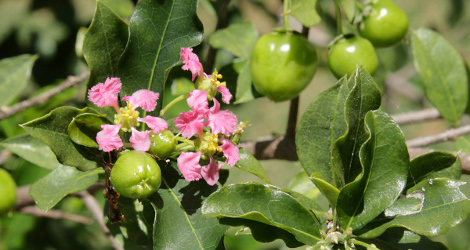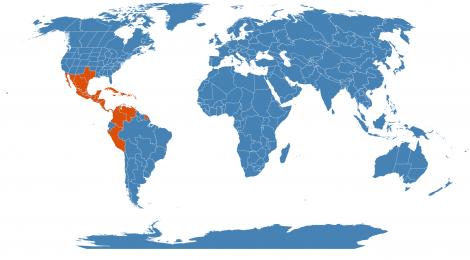Accession Data:
Malpighia glabra L.
- Common Name: Barbados Cherry, Acerola
- Family: Malpighiaceae Juss.
- Description: A tropical American tree. Fruit has a high vitamin C content and calcium and iron among its minerals. A slow grower which will reach 10 feet in a favorable environment, but only about 6 feet when container grown. Has a shrubby growth habit; young leaves are wine colored turning dark green. A tough, versatile plant that will grow in most soils, but will do better in a composted sandy loam. The thin-skinned fruit is cherry-like, red to crimson, semi-sweet to acid. Bears in its third year. Fruit is borne on previous year's growth and ripens a few days after flowering.
- Culture: Propagation is by seeds but generally from cuttings in the summer and air layering.
- USDA Zone: 10-12
Accession Data:
- Accession # 198500465
- Source: Unknown
- Accession Date: 12-31-1985
- Bench: 1304 - NEOA: North Bench W
- Currently: active - healthy
- Qty: 1 confirmed on 03-12-2025
Classification:
- Division: Magnoliophyta
- Class: Magnoliopsida
- SubClass: eurosid I
- Order: Malpighiales
- SubOrder:
- Family: Malpighiaceae
- SubFamily:
- Tribe:
- SubTribe:
Flowering Data:
This accession has been observed in bloom on:| Year | Jan | Feb | Mar | Apr | May | Jun | Jul | Aug | Sep | Oct | Nov | Dec | ||||||||||||||||||||||||||||||||||||||||
|---|---|---|---|---|---|---|---|---|---|---|---|---|---|---|---|---|---|---|---|---|---|---|---|---|---|---|---|---|---|---|---|---|---|---|---|---|---|---|---|---|---|---|---|---|---|---|---|---|---|---|---|---|
| 2025 | ||||||||||||||||||||||||||||||||||||||||||||||||||||
| 2024 | ||||||||||||||||||||||||||||||||||||||||||||||||||||
| 2023 | ||||||||||||||||||||||||||||||||||||||||||||||||||||
| 2022 | ||||||||||||||||||||||||||||||||||||||||||||||||||||
| 2021 | ||||||||||||||||||||||||||||||||||||||||||||||||||||
| 2020 | ||||||||||||||||||||||||||||||||||||||||||||||||||||
| 2019 | ||||||||||||||||||||||||||||||||||||||||||||||||||||
| 2018 | ||||||||||||||||||||||||||||||||||||||||||||||||||||
| 2017 | ||||||||||||||||||||||||||||||||||||||||||||||||||||
| 2016 | ||||||||||||||||||||||||||||||||||||||||||||||||||||
| 2015 | ||||||||||||||||||||||||||||||||||||||||||||||||||||
| 2014 | ||||||||||||||||||||||||||||||||||||||||||||||||||||
| 2013 | ||||||||||||||||||||||||||||||||||||||||||||||||||||
| 2012 | ||||||||||||||||||||||||||||||||||||||||||||||||||||
| 2011 | ||||||||||||||||||||||||||||||||||||||||||||||||||||
| 2010 | ||||||||||||||||||||||||||||||||||||||||||||||||||||
| 2009 | ||||||||||||||||||||||||||||||||||||||||||||||||||||
| 2008 | ||||||||||||||||||||||||||||||||||||||||||||||||||||
| 2007 | ||||||||||||||||||||||||||||||||||||||||||||||||||||
References (internal):
- EEB Greenhouse Holdings native to: Texas / Mexico Central / Mexico Northeast / Mexico Gulf / Mexico Northwest / Mexico Southwest / Mexico Southeast / Belize / Costa Rica / El Salvador / Guatemala / Honduras / Nicaragua / Panama / Aruba / Cuba / Dominican Republic / Haiti / Leeward Is. / Jamaica / Netherlands Antilles / Puerto Rico / Venezuelan Antilles / French Guiana / Venezuela / Colombia / Peru
References (external):
- Morton, J. 1987. Barbados Cherry. p. 204–207. In: Fruits of warm climates. Julia F. Morton, Miami, FL. Last accessed on Monday, July 24, 2017.
- Acerola Fruit Facts at California Rare Fruit Growers. Last accessed on Monday, July 24, 2017.
- The Plant List (2013). Version 1.1. Last accessed on Monday, July 24, 2017.
- Malpighia glabra at Global Biodiversity Information Facility. Last accessed on Monday, July 24, 2017.
- Image #00 (cropped) & #01 (original) by Eric Gaba (Sting - fr:Sting) (Own work) [CC BY-SA 3.0 or GFDL], via Wikimedia Commons. Last accessed on Monday, July 24, 2017.
data regenerated on Wed, 02 Jul 2025 09:54:58 -0400 [bcm v4.0]
Images:

Additional images for this accession:
Click on thumbnails to enlargeCurrent Accessions in the Malpighiaceae
- Acridocarpus natalitius

- Acridocarpus zanzibaricus W/C



- Banisteriopsis caapi


- Galphimia gracilis



- Malpighia coccigera


- Malpighia glabra


- Microsteira sp. W/C

- Stigmaphyllon ciliatum


- Tristellateia australasiae


 = indicates flowering in past 14 days
= indicates flowering in past 14 days
 = images available for this accession
= images available for this accession
 = map available for this accession
= map available for this accession
 = accession added within past 90 days
= accession added within past 90 days

